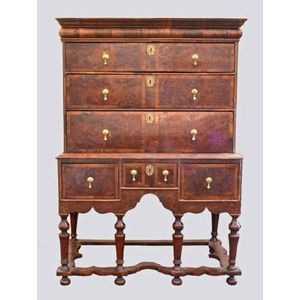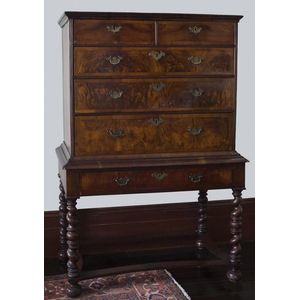1730 William & Mary Chest-on-Stand
You must be a subscriber, and be logged in to view price and dealer details.
Subscribe Now to view actual auction price for this item
When you subscribe, you have the option of setting the currency in which to display prices to $Au, $US, $NZ or Stg.
- Barley Twist - The leg, and frequently other uprights such as columns, chair frames, spindles and stretchers, are turned in fairly wide and deep spirals, usually slightly rounded. Also known as the 'Jacobean twist' and common on the dark stained Jacobean Revival furniture of the 1930s and 40s.
As a rule, the twists on opposite uprights should move in a contrary direction. Thus, if the spiral on a right side is clockwise, that on the left side should move in a counter-clockwise direction.
This is also true of rope-twist or cable-twist turning, a nautical term that came into fashion after Nelson's victories over the French fleet. The essential difference is that with rope twists, the spirals are more finely turned on the lathe and placed closer together, than they are with barley-sugar turnings. - Skirt - In furniture, the skirt is a strip of wood underneath the top or front of the item. On chairs, the skirt is the support under the seat joining the legs, while on tables, the skirt is the support under the top, that assists in supporting the top and also joins the legs. On carcase furniture such as chests and cabinets, the skirt is the timber strip immediately under the drawers or cupboard.
- Cornice - The upper section of a high piece of furniture such as a bookcase, wardrobe or cabinet that sits immediately on the main structure. The cornice is usually decorated with a variety of architectural mouldings, worked either with a moulding plane or, from the later 19th century, by machine. The front and side of the cornice are mitred together, strengthened by glue blocks, and the back is generally a simple dovetailed rail to hold the structure together. Cornices are generally, though not always, fitted separately to the piece and are held in place either by screws sunk into the top board or by wooden corner blocks. A pediment may sit above the cornice, but sometimes the terms cornice and pediment are used interchangeably.
- Circa - A Latin term meaning 'about', often used in the antique trade to give an approximate date for the piece, usually considered to be five years on either side of the circa year. Thus, circa 1900 means the piece was made about 1900, probably between 1895 and 1905. The expression is sometimes abbreviated to c.1900.
- Turned Legs - are legs which have been turned on a lathe. In use from the 16th century, turned legs on tables, chairs and cabinets became more frequent until, by the 1830s, the Georgian square or tapered leg was rarely found except in country pieces.
- Escutcheons - An escutcheon is a plate, made of brass, wood, ivory or ebony, which fits into or over the h keyhole, to protect the edge of the timber keyhole from damage by continual insertions of the key. As a general rule you would expect these escutcheons to be sympathetic in design to the handles of the piece. From the early 19th century escutcheons were sometimes made from ivory, ebony, bone or contrasting wood, often cut in a diamond or shield shape and inlaid into the front. Ivory, in particular, will tend to discolour with age, and certainly should not show up as brilliantly white.
- Turning - Any part of a piece of furniture that has been turned and shaped with chisels on a lathe. Turned sections include legs, columns, feet, finials, pedestals, stretchers, spindles etc. There have been many varieties and fashions over the centuries: baluster, melon, barley-sugar, bobbin, cotton-reel, rope-twist, and so on. Split turning implies a turned section that has been cut in half lengthwise and applied to a cabinet front as a false decorative support.
This item has been included into following indexes:
Visually similar items

A Queen Anne walnut chest-on-stand, English, circa 1710

George I oak chest on stand with two short and three long drawers, the base with three short and one long drawer on turned legs four pad feet

A William & Mary style chest on stand 18th century and later the chest is walnut with figured veneers, having three full size drawers and upper secretive drawer the base is a turned six leg stretcher type construction having three upper drawers. Height 144

A figured walnut chest on stand, English, early 18th century. 150 cm high, 98 cm wide, 51 cm deep
